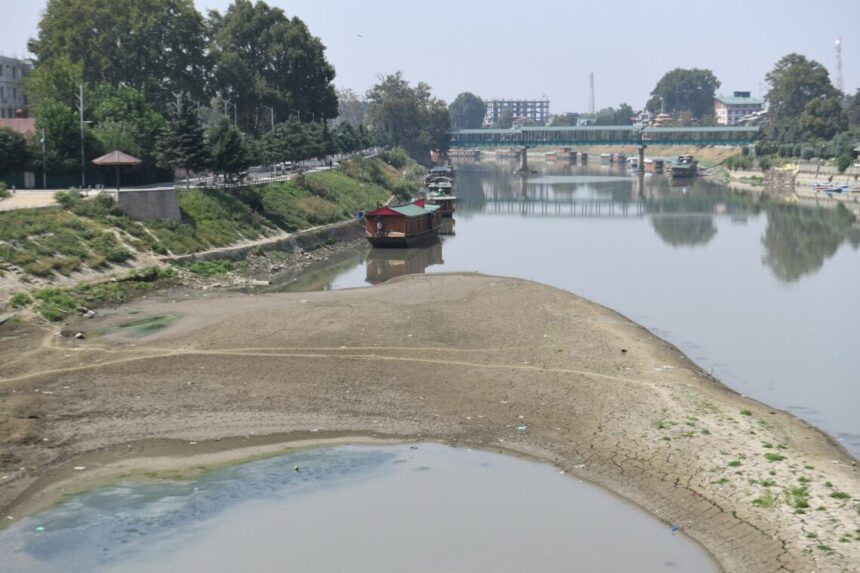Region at the Crossroads of Climate Change
In the heart of the Himalayan landscape, a profound environmental transformation is unfolding, with the Jhelum River emerging as a critical indicator of the region’s changing ecological dynamics. Kashmir, once known for its lush landscapes and abundant water resources, now faces an unprecedented climate crisis that threatens its environmental, economic, and social foundations.
Hydrological Crisis: Measuring the Decline
The current hydrological measurements paint a stark and alarming picture. At the Sangam point, the river is flowing at an unprecedented -0.75 feet, while at Ram Munshi Bagh, water levels have dramatically dropped to just 3.73 feet. These are not merely statistical anomalies, but powerful signals of a deeper environmental disruption that is systematically reshaping the region’s water ecosystem.
Glacial Dynamics: The Melting Himalayan Landscape
Glacial dynamics lie at the core of this environmental metamorphosis. The region hosts 18,000 glaciers, with a staggering 30% already lost over the past six decades. Scientists project that by the end of this century, up to 70% of these critical water sources could disappear. The Kolahoi Glacier, Kashmir’s largest glacial system, epitomizes this transformation, receding at an alarming rate of 35 meters annually—a testament to the accelerating impact of climate change.
Climate Patterns: The New Environmental Normal
Temperature and precipitation patterns have become increasingly erratic, fundamentally altering the region’s ecological balance. Since October 2024, the area has experienced prolonged dry spells, with winter precipitation consistently falling below historical norms. Climate scientists predict a potential temperature increase of 4-7 degrees Celsius by 2100, a projection that suggests the current environmental changes may be irreversible.
Socio-Economic Implications: Beyond Environmental Metrics
The implications of this water crisis extend far beyond environmental metrics. Local communities are witnessing direct and profound impacts on their daily lives. Water supply infrastructures are becoming increasingly compromised, agricultural practices are facing unprecedented challenges, and traditional livelihood patterns are being systematically disrupted. The potential for drinking water shortages looms large, threatening the region’s human and ecological sustainability.
Scientific Perspectives: Voices of Expertise
Experts like Dr. Faizan Arif Keng and Dr. Irfan Rashid from the University of Kashmir have been instrumental in documenting and understanding these transformations. Their research highlights not just the symptoms of climate change, but also the urgent need for comprehensive mitigation and adaptation strategies. They emphasize that the Jhelum River’s condition is more than a local issue—it represents a critical case study in understanding mountain ecosystem vulnerabilities.
Mitigation and Adaptation Strategies
The path forward requires a multifaceted approach. Immediate interventions must include:
- Advanced water conservation techniques
- Climate-resilient agricultural practices
- Sustainable infrastructure development
- Community-based ecological monitoring
Long-term strategies should focus on:
- Renewable energy investments
- Carbon emission reduction
- Comprehensive climate adaptation programs
- International collaborative research
Technological Innovations
Technology will play a crucial role in addressing these challenges. Potential solutions include:
- Satellite-based glacier monitoring
- Artificial snow generation technologies
- Water harvesting and storage innovations
- Precision agriculture techniques
- Advanced climate modeling
Global Context: A Microcosm of Planetary Change
What makes Kashmir’s situation particularly significant is its representation of a global environmental challenge. The region serves as a powerful microcosm of the broader climate change impacts affecting mountain ecosystems worldwide. Each receding glacier and each drop in river water levels tells a story of environmental transformation that demands immediate global attention and coordinated action.
Need for a Global Action
Jhelum River continues to reveal its diminishing waters, it sends a powerful message about the intricate relationship between human societies and natural systems. It is a reminder that our environmental challenges are interconnected, transcending local and national boundaries.
There is a need for global cooperation involving innovative thinking and a fundamental reimagining of our relationship with the natural world. It challenges us to look beyond immediate concerns and consider the long-term sustainability of our planet’s most critical ecosystems.
The future of Kashmir—and potentially similar mountain regions globally—depends on our collective ability to understand, respond to, and potentially mitigate these profound environmental changes.







